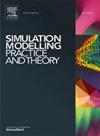A data-driven friction coefficient model and its application in meshing efficiency prediction of heavy-duty gears
IF 3.5
2区 计算机科学
Q2 COMPUTER SCIENCE, INTERDISCIPLINARY APPLICATIONS
引用次数: 0
Abstract
Heavy-duty gears are extensively utilized in high-power equipment such as helicopters, ships, and commercial vehicles, often leading to significant frictional power losses. Accurate friction prediction is essential for designing energy-efficient transmission systems. This study proposes a data-driven model to predict the friction coefficient and applies it to estimate the meshing efficiency of heavy-duty gears. By training on friction test data under various lubrication conditions, an extreme gradient boosting (XGBoost) model is developed to predict the friction coefficient, with hyperparameters optimized through grid search and cross-validation. The model’s decision mechanism is interpreted using Shapley additive explanations, highlighting the influence of speed, load, surface roughness, and lubricant viscosity on the friction coefficient. When applied to predict meshing efficiency, the model is experimentally validated, achieving a maximum prediction error of 0.211 % and an average error of 0.108 %. The effects of major operating and geometrical parameters are analyzed, showing that meshing efficiency increases with higher speeds, torque, pressure angles, tip relief length, and lower addendum coefficients. The results indicate that proper parameter optimization and the use of high-viscosity lubricants can enhance the energy efficiency of heavy-duty gears.
数据驱动的摩擦系数模型及其在重型齿轮啮合效率预测中的应用
重型齿轮广泛应用于高功率设备,如直升机,船舶和商用车辆,经常导致显著的摩擦功率损失。准确的摩擦预测对设计节能传动系统至关重要。提出了一种数据驱动的摩擦系数预测模型,并将其应用于重载齿轮的啮合效率估算。通过对不同润滑条件下的摩擦试验数据进行训练,建立了预测摩擦系数的极限梯度增压(XGBoost)模型,并通过网格搜索和交叉验证优化了超参数。该模型的决策机制使用Shapley添加剂解释来解释,突出了速度、负载、表面粗糙度和润滑剂粘度对摩擦系数的影响。将该模型用于预测网格效率,并进行了实验验证,最大预测误差为0.211%,平均预测误差为0.108%。分析了主要工作参数和几何参数对啮合效率的影响,表明转速、转矩、压力角、叶尖卸荷长度和齿顶系数越小,啮合效率越高。结果表明,适当的参数优化和高粘度润滑剂的使用可以提高重型齿轮的能量效率。
本文章由计算机程序翻译,如有差异,请以英文原文为准。
求助全文
约1分钟内获得全文
求助全文
来源期刊

Simulation Modelling Practice and Theory
工程技术-计算机:跨学科应用
CiteScore
9.80
自引率
4.80%
发文量
142
审稿时长
21 days
期刊介绍:
The journal Simulation Modelling Practice and Theory provides a forum for original, high-quality papers dealing with any aspect of systems simulation and modelling.
The journal aims at being a reference and a powerful tool to all those professionally active and/or interested in the methods and applications of simulation. Submitted papers will be peer reviewed and must significantly contribute to modelling and simulation in general or use modelling and simulation in application areas.
Paper submission is solicited on:
• theoretical aspects of modelling and simulation including formal modelling, model-checking, random number generators, sensitivity analysis, variance reduction techniques, experimental design, meta-modelling, methods and algorithms for validation and verification, selection and comparison procedures etc.;
• methodology and application of modelling and simulation in any area, including computer systems, networks, real-time and embedded systems, mobile and intelligent agents, manufacturing and transportation systems, management, engineering, biomedical engineering, economics, ecology and environment, education, transaction handling, etc.;
• simulation languages and environments including those, specific to distributed computing, grid computing, high performance computers or computer networks, etc.;
• distributed and real-time simulation, simulation interoperability;
• tools for high performance computing simulation, including dedicated architectures and parallel computing.
 求助内容:
求助内容: 应助结果提醒方式:
应助结果提醒方式:


